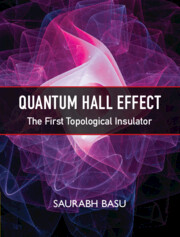Book contents
- Frontmatter
- Dedication
- Contents
- Foreword
- Preface
- Acknowledgements
- 1. Quantum Hall Effect
- 2. Symmetry and Topology
- 3. Topology in One-Dimensional (1D) and Quasi-1D Models
- 4. Quantum Hall Effect in Graphene
- 5. Graphene as a Topological Insulator: Anomalous Hall Effect
- 6. Fractional Quantum Hall Effect
- Epilogue
- Bibliography
- Index
Foreword
Published online by Cambridge University Press: aN Invalid Date NaN
- Frontmatter
- Dedication
- Contents
- Foreword
- Preface
- Acknowledgements
- 1. Quantum Hall Effect
- 2. Symmetry and Topology
- 3. Topology in One-Dimensional (1D) and Quasi-1D Models
- 4. Quantum Hall Effect in Graphene
- 5. Graphene as a Topological Insulator: Anomalous Hall Effect
- 6. Fractional Quantum Hall Effect
- Epilogue
- Bibliography
- Index
Summary
Traditionally the different states of matter are described by symmetries that are broken. Typical situations include the freezing of a liquid, which breaks the translational symmetry that the fluid possessed, and the onset of magnetism, where the rotational symmetry is broken by the ordering of the individual magnetic moment vectors. In the early eighties of the previous century a completely new organizational principle of quantum matter was introduced following the discovery of the quantum Hall effect. The robustness of the quantum Hall state was a forerunner of the variety of topologically protected states that forms a large fraction of the condensed matter physics and material science literature at present.
Given the rapid strides that this field has made in the last two decades, it is almost imperative that it should become a part of the senior undergraduate curriculum. This necessitates the existence of a textbook that can address these somewhat esoteric topics at a level which is understandable to those who have not yet decided to specialize in this particular field but very well could, if given a proper exposition. This is a rather difficult task for the author of a textbook of a contemporary topic, and this is where the present book is immensely successful.
I am not a specialist in this subject by any means and found the book to be a comprehensive introduction to the area. I am sure the senior undergraduates and the beginning graduate students will benefit immensely from the book.
Jayanta K. Bhattacharjee
School of Physical Sciences,
Indian Association for the Cultivation of Science
Jadavpur, Kolkata
- Type
- Chapter
- Information
- Quantum Hall EffectThe First Topological Insulator, pp. xi - xiiPublisher: Cambridge University PressPrint publication year: 2024



